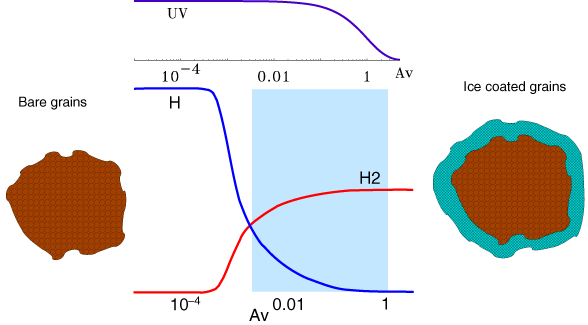Table 7
Synthetic table giving the characteristic times of destruction and formation processes of the aliphatic hydrogenated carbon component in the different phases of the interstellar medium.
| Interstellar phase | Diffuse | Interface a | Dense | |
|
|
||||

|
||||
|
|
||||
| Visual extinction | AV(mag) | <10-4 | 10-4 − 1 | >1 |
| Density | n (cm-3) | 1−100 | 102−104 | 104−108 |
| Energy deposited | UV ≫ CR | UVCRinduced ~ 10 × CRb | ||
| Atomic or molecular hydrogen | H ≫ H2 | H < H2 | H ≪ H2 | |
|
|
||||
| Dynamical time | tdyn (years) | 108c | ≲107d | ~few 107e |
| Destruction time by CR | td,CR (years) | 108 | 108 | 108 |
| Destruction time by UV photons | td,UV (years) | 4 × 103f | ≳4.103exp(AV) | ≳107g |
| Formation time by atomic H | tf,H (years) | 2 × 103h | less efficient than in diffuse ISM | inefficient?i |
|
|
||||
| Destruction/Formation | Efficient formation | Efficient destruction? | Slow destruction | |
Notes. The destruction and formation characteristic times can be compared to the dynamical time, i.e., the approximate time spent in each of these phases.
The figure is adapted from Le Petit et al. (2006). The blue zone emphasises the transition zone between atomic and molecular hydrogen.
The local UV field induced by cosmic rays deposits more energy than cosmic rays themselves (Shen et al. 2004). However, because the penetration depth of photons is smaller, the ice mantles are more UV processed, whereas the internal part of grains is dominated by cosmic ray energy deposition.
E.g., Jones et al. (1994).
McKee (1989); Draine (1990); Jones et al. (1994); Tassis & Mouschovias (2004); Mouschovias et al. (2006); Elmegreen (2007).
Mennella et al. (2001) (σd,UV = 1.0 × 10-19 cm2/photon), Mathis et al. (1983) (interstellar radiation flux of about 8 × 107 photons cm-2 s-1).
Mennella et al. (2001) (σd,UV = 1.0 × 10-19 cm2/photon), Prasad & Tarafdar (1983) (flux of internal UV field due to CR of 103−104 photons cm-2 s-1). This results in a characteristic destruction time by an internal UV field of 107−108 yr. Once the ice mantles appear on the dust grains (AV ≳ 3, (Whittet et al. 1988; Smith et al. 1993; Murakawa et al. 2000)), the refractory material is partly protected from the UV via the photochemical interaction in these mantles.
Mennella (2006) (σf,H = 1.7 × 10-18 cm2/H atom), Sorrell (1990) (flux of 8 × 106 H atoms cm-2 s-1 in diffuse clouds).
See the first two paragraphs of Sect. 4.6.2 for details.
Current usage metrics show cumulative count of Article Views (full-text article views including HTML views, PDF and ePub downloads, according to the available data) and Abstracts Views on Vision4Press platform.
Data correspond to usage on the plateform after 2015. The current usage metrics is available 48-96 hours after online publication and is updated daily on week days.
Initial download of the metrics may take a while.


